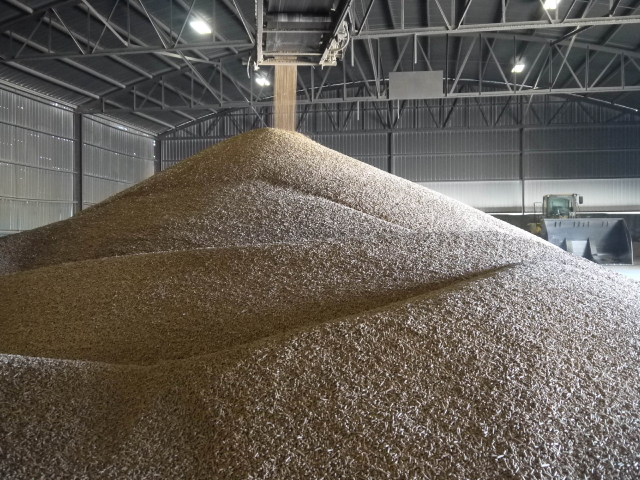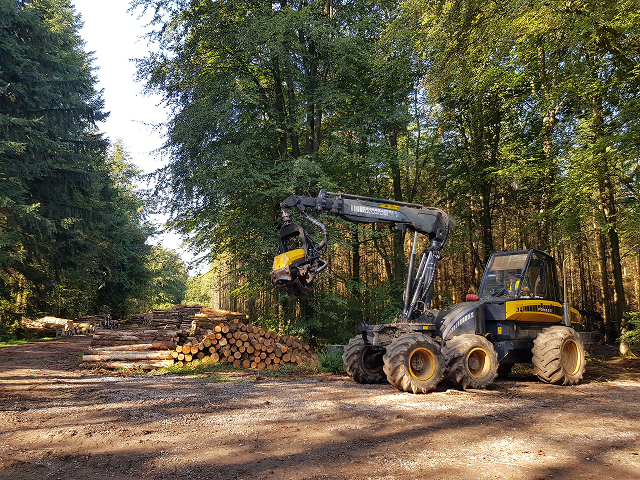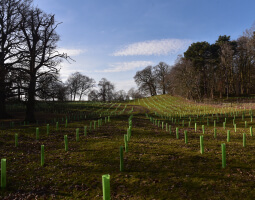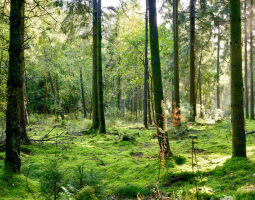Forest Bioenergy
Bioenergy is energy produced from any material of biological origin (biomass). The UK uses forest-derived biomass, as well as other biomass types such as food waste, wood waste and energy crops, to produce heat and power.
The use of forest biomass for energy generation can provide an additional revenue source to forest owners who are managing their forests for timber, or as part of other management activities. Its use can help with reducing fossil fuel carbon emissions, but care is needed when producing bioenergy from forests and agricultural systems because in the wrong circumstances its use can cause carbon emissions as high as fossil fuels. A sustainability framework is therefore required to support the use of forest bioenergy with low carbon emissions.
Carbon balance animation – Supergen Bioenergy Hub (2022)
Forest Biomass as an Energy Source
Government Statistics reported that in 2023, forest-derived biomass generated approximately 7% of the UK’s total power, and 58% of the renewable heat production, contributing nearly a third of all renewable energy generated (heat, power, and transport fuels).
In the UK, most domestic forest biomass extracted for energy is used for heating, whilst most of the forest biomass used in the power sector is imported. In 2023, the UK produced approximately 4.6 million tonnes of woodfuel from harvested timber and the waste wood sector. In the same year the UK imported around 6.4 million tonnes (Mt) of wood pellets, 81% of which came from North America, and 10% from the Baltic States.
In the Southeastern US, where most of the wood pellets currently used in the UK are produced, pellets generally originate from low value material from conventional forestry and processing operations. In this region the volume of wood used for pellets is a small proportion of the total material harvested, estimated to comprise less than 1% of US forest products by weight, and 5% of the total wood products extracted from the southeastern region.
Forest bioenergy can help reduce greenhouse gas (GHG) emissions compared to use of fossil fuels. Quantifying these benefits is not always straightforward, however, as it depends on the type of forest the material is harvested from, and how that forest is being managed. The benefits also depend on what other viable uses the material could have, and alternative energy generation options.
Generally, bioenergy will provide carbon benefits if it is produced from lower value material that is harvested as part of conventional forest management, and is a by-product of harvesting for higher value products such as sawlogs for sawn timber, or would be left as waste if not used for bioenergy. This page can only offer an overview of this complex topic, and you’ll find more detailed information in the ‘Further resources’ section at the end.
Forest Biomass as a Low-Carbon Fuel
The main reasoning behind using biomass as a low-carbon energy source is that trees remove CO2 from the atmosphere during growth, which is then returned to the atmosphere when the biomass is burnt, but the energy generated replaces the burning of fossil fuels, avoiding the release of CO2 that has been locked away on geological time scales.
Energy generation using biomass is often described as “carbon neutral”, but this is a simplified way of summarising the cyclical process of carbon sequestration and CO2 emissions involved in growing and managing forests. It can be challenging to conceptualise all the carbon flows involving forests, which grow over a long period of time, and over landscapes, and effects of forest management including harvesting for wood products and biomass use.
As explained in the Carbon Sequestration page, the carbon impact of harvesting should be understood in the context of the whole forest, rather than focusing on the single tree or stand. If portions of a wider forest or landscape are at different stages of growth, including some regrowing after harvest, then the whole forest area may reach a net balance between carbon emissions and uptake even as some harvesting occurs.

Wood pellets at a wood pellet plant

Types of Forest Biomass Used for Energy
The use of forest biomass can also be controversial because of concerns that high quality, mature trees could be being used for energy instead of for more valuable and longer-lived wood products. However, it is usual for foresters to sort through harvested material, grading it for different markets.
Harvesting operations usually require a financial gain, and landowners would not choose to supply sawlog-grade material to the biomass market, as it is generally high value. Instead, the bioenergy market can benefit forest owners by providing a market for the lowest value woody material, and this can enable them to manage their forests better. Without the bioenergy market this material would be left to decay on-site, or even burnt at the roadside in some regions (releasing the CO2 back into the atmosphere without any fossil fuel substitution benefits). Therefore, carbon savings can be achieved if the material is instead used to provide energy and avoid the use of fossil fuels.
Wood-based biomass can also be produced from sawmill residues, such as sawdust. The conversion of sawlogs into timber is about 50-55% efficient, meaning that around 45-50% of the material ends up as residues, which can be used for energy.
Sometimes it is argued that the emissions from burning biomass are a major concern, however this ignores that in most cases, the biomass market makes use of excess or poorer quality material that would otherwise be left on-site to decay or actively burned. Another view is that once carbon is sequestered in biomass material, it should be retained there, and therefore the biomass industry can only have negative impacts. However, this argument is selective and imbalanced as it focuses on negative impacts of forest harvesting whilst not allowing the possibility that forest management could also be actively contributing to carbon sequestration.
In real-life situations, the overall impact of forest bioenergy use on carbon emissions can be beneficial, neutral or worse than fossil fuels, depending on how the forests are managed and the biomass used. However, causing high emissions when using forest bioenergy needs to be avoided.
How the UK Reports the Carbon Emissions from Bioenergy
It is a common misconception that CO2 emissions from forest biomass combustion are ignored. Every year, the UK reports its national GHG emissions as part of its commitment to the United Nations Framework Convention on Climate Change (UNFCCC). To monitor and report the carbon emissions from forests, the UNFCCC requires that both carbon sequestration from forest growth and carbon losses from forest harvesting are reported. GHG emissions from forest bioenergy are reported as part of the net sequestration and emissions from forest management, rather than from energy use. If the emissions from bioenergy were reported as part of energy use as well, this would mean they would be double-counted.
However, UNFCCC reporting does not in itself ensure that forest-derived bioenergy is low carbon, it only ensures that the carbon emitted is reported. It does not provide a suitable framework for identifying the net carbon emissions from forest bioenergy harvesting and use, and there are valid concerns about high emissions being caused by increasing bioenergy use, sometimes referred to as a ‘carbon debt’.
For this reason, all UK Government schemes supporting bioenergy have sustainability criteria that must be met. Sustainability criteria include requirements around maintaining productivity and ensuring harvest levels do not exceed the long-term productive capacity of the forest, based on forest inventory, growth and yield data. Some biomass users opt to use certification schemes to assure that a fuel meets part or all of the sustainability criteria. For example, the Sustainable Biomass Program has developed a certification scheme to provide assurance that woody biomass is sourced both legally and sustainably.
Emissions from Importing Wood Pellets
Sustainability criteria generally require that the GHG emissions from the supply chain from harvesting, pelleting, drying and transporting wood pellets cannot exceed an allowed threshold, otherwise it does not qualify as sustainable. These supply chain emissions are well understood and help to ensure the GHG emissions from the supply of forest bioenergy can be significantly lower than emissions from fossil fuels. These emissions occur along the supply chain, possibly in countries other than the UK, and will change with time as transport and power grids decarbonise.
The Future Use of Bioenergy
The supply of forest biomass for energy will be limited by the amount that can be sustainably extracted while also avoiding high carbon emissions. It is therefore important to use it as effectively as possible to maximise the carbon savings achievable. In the UK power sector, the use of biomass has helped substantially in eliminating the use of coal over the last decade. Since the cost of offshore wind and solar electricity generation has reduced significantly, there are developing opportunities where biomass can help with climate change mitigation.
A possible innovation is to combine biomass use with carbon capture and storage (known as BECCS), which both provides low carbon energy and, ideally, permanently captures and stores the CO2 that the forest removed from the atmosphere by sequestering it in geological formations. There are several BECCS projects already under way across the globe, and whilst this is not a new technology, it has not yet been deployed at the scales required to meet net zero. The UK’s geology is considered particularly suitable for carbon storage, which means we may see more innovation and uptake of BECCS technologies in the future.




